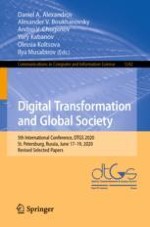2020 | Book
Digital Transformation and Global Society
5th International Conference, DTGS 2020, St. Petersburg, Russia, June 17–19, 2020, Revised Selected Papers
Editors: Daniel A. Alexandrov, Alexander V. Boukhanovsky, Andrei V. Chugunov, Yury Kabanov, Olessia Koltsova, Ilya Musabirov
Publisher: Springer International Publishing
Book Series : Communications in Computer and Information Science
